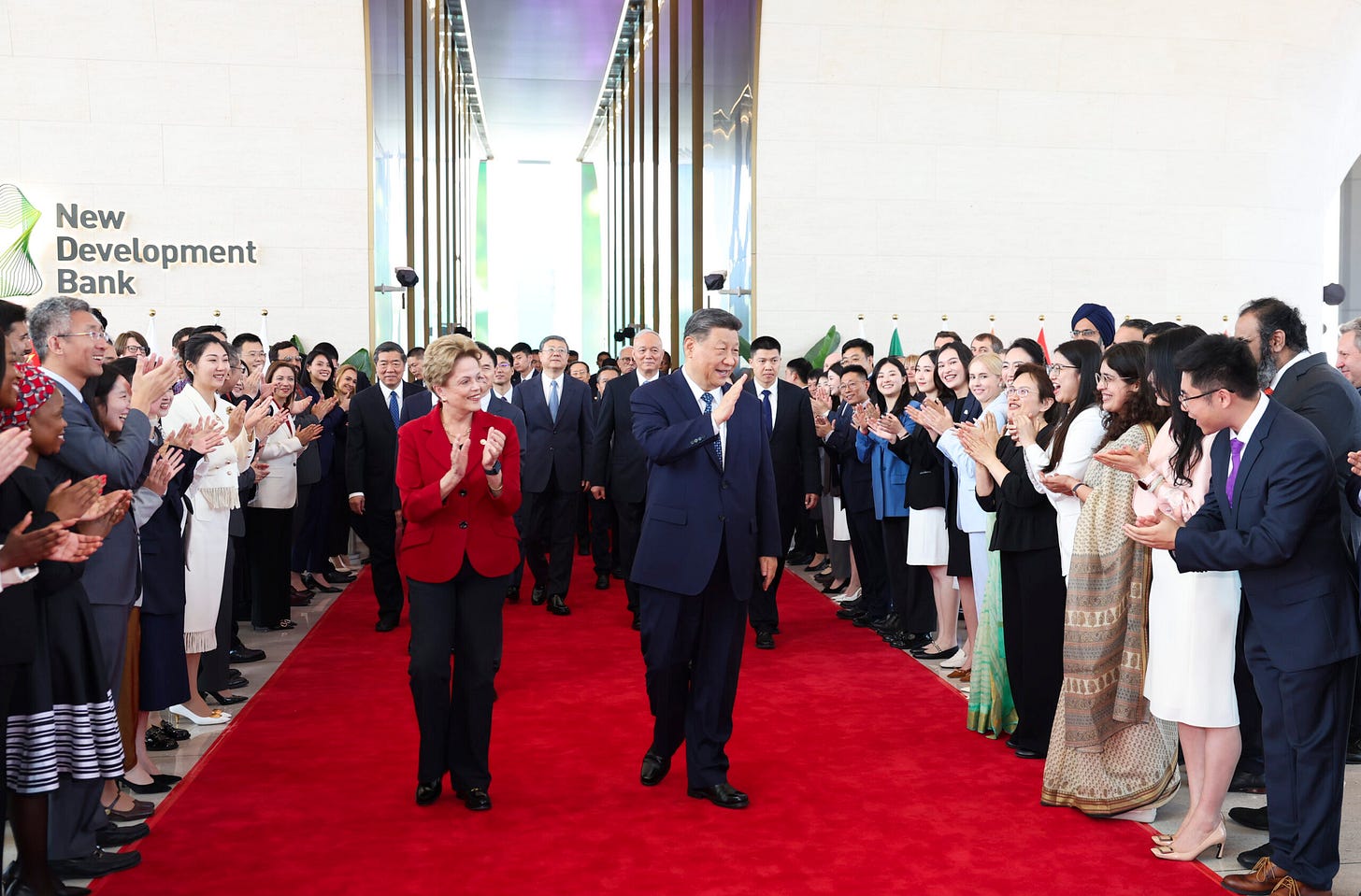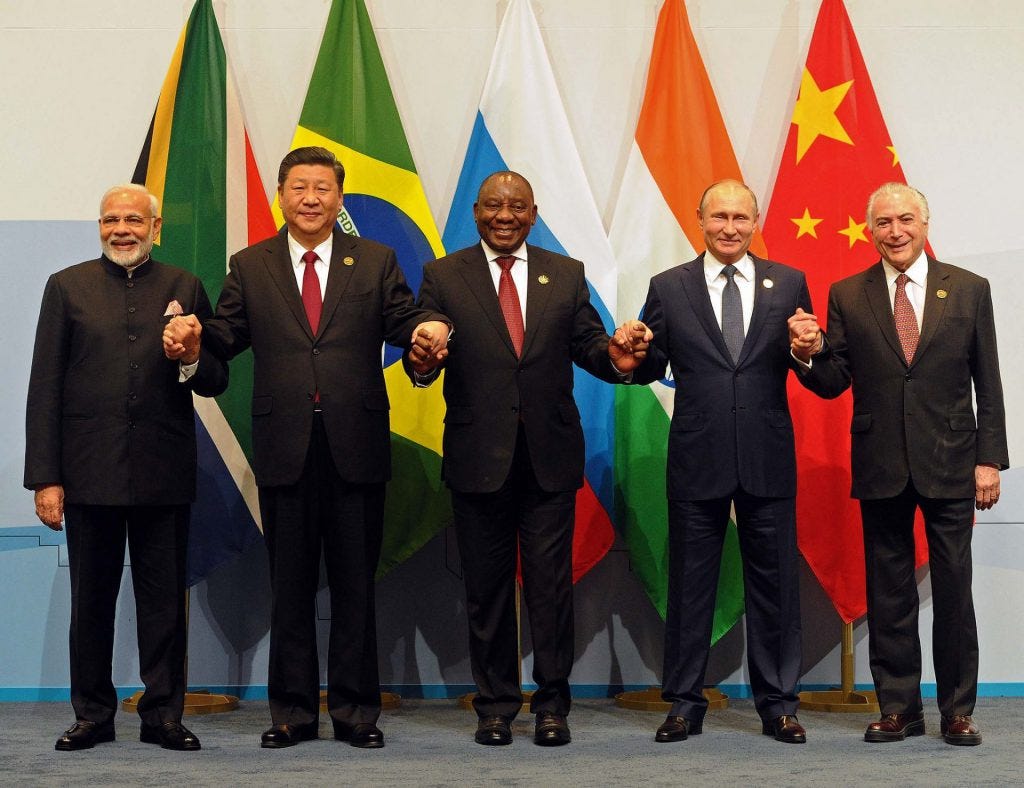BRICS: Who’s who and what’s what
A comprehensive update on the world's most dynamic intergovernmental alliance.
A Movement, Not a Bloc
BRICS today is no longer a geopolitical acronym. It is a collective vision-an economic counterweight, a moral statement, and a strategic alliance of nations that dare to imagine development without domination.
As of 2025, BRICS is ten full members strong, but 44 more countries are lined up to join. Why? Because BRICS does what others only promise-
BRICS builds without conquest, it lends without conditionality, and it respects sovereignty without exception.
This report is not about how BRICS began-that’s for the next report. Here, we map what BRICS is now: its structure, expansion, guiding principles, institutions, and numbers-and why it matters more than ever.
Please support my work by becoming a paid subscriber and ill support you with important well researched reports about the world we live in. We are in this together.
The Fortaleza Breakthrough:
BRICS Finds Its Engine
At the VI BRICS Summit in Fortaleza, Brazil (2014), a new chapter opened. Two transformative institutions were created:
The New Development Bank (NDB)
The Contingent Reserve Arrangement (CRA)
The motivation? A joint viability study by member states found that:
Existing institutions like the IMF and World Bank weren’t meeting the infrastructure needs of the Global South.
International credit conditions were becoming narrower and more risk-averse post-2008.
The NDB was launched to plug that gap-with founding principles of equal voting rights, a higher risk appetite, and a development-first mandate. It’s run by developing countries, for developing countries.
As of 2025:
Authorized Capital: $100 billion
Paid-in Capital: $52.7 billion
Approved Projects: 120+
Disbursed Funds: $39 billion
Membership: Expanded to include Egypt, UAE, and Bangladesh
In sharp contrast to the IMF’s GDP-weighted voting model, the NDB gives all founding members equal say, regardless of economic size. This single principle-equality in voice-is why developing nations are flocking to BRICS.
Current BRICS Members (as of 2025)
Who Wants In? The 44-Nation Wave
BRICS not random expansion. It’s expanding because its values resonate. As of 2025:
23 nations have formally applied
21 have expressed interest
Applicants include:
Algeria, Argentina, Bahrain, Bangladesh, Belarus, Bolivia, Cuba, Egypt, Ethiopia, Honduras, Indonesia, Iran, Kazakhstan, Nigeria, Pakistan, Saudi Arabia, Senegal, Sudan, Syria, Thailand, Tunisia, UAE, Venezuela
Interested partners include:
Afghanistan, Angola, Armenia, Azerbaijan, Cambodia, Congo, Gabon, Guinea-Bissau, Malaysia, Mexico, Nicaragua, Nigeria, Philippines, Sri Lanka, Suriname, Uganda, Uzbekistan, Vietnam, Yemen, Zimbabwe
Regional Mini-BRICS: Continental Cooperation Models
To manage its growing scale and diverse membership, BRICS has quietly evolved into three regional formations:
BRICS-Africa
Anchored by South Africa, Egypt, and Ethiopia. Focus: infrastructure, green energy, agriculture, and water security.BRICS-Middle East
With Iran, UAE, and Saudi Arabia (applicant). Focus: financial de-dollarization, energy innovation, sovereign development funds.BRICS-Asia
With India, China, Indonesia, and potential members like Malaysia and Vietnam. Focus: AI governance, digital currency frameworks, and multilateral tech platforms.
These hubs serve as BRICS local engines, maintaining unity while honoring regional needs.
BRICS in Numbers: 2025
BRICS is now one of the largest economic coalitions in history. Here's where it stands-and where it’s headed if all 44 applicants join.
Also worth noting:
48.5% of the world’s population lives in BRICS countries
24% of all global trade is BRICS-based
Brazil’s trade with BRICS alone reached $210 billion in 2024
BRICS now spans 36% of Earth’s landmass, across every inhabited continent
Ethiopia: A Test Case for the BRICS Model
Ethiopia’s 2024 accession is more than symbolic-it’s structural.
Nearly half its foreign debt is owed to China
It maintains positive bilateral relations with Russia, South Africa, and India
It’s emerging from conflict with hopes of economic renewal
Access to the NDB gives Ethiopia something no IMF loan ever offered: agency. And it sends a global message-if BRICS believes in Ethiopia’s future, others should too.
The Institutional Triad
1. New Development Bank (NDB)
Mandate: Fund sustainable infrastructure
Recent Projects: Green energy in Brazil, logistics corridors in India, smart cities in South Africa
Notable Feature: Equal voting power for all founders, no U.S. veto
On April 29, 2025, H.E. Xi Jinping, President of the People’s Republic of China, visited the New Development Bank (NDB) Headquarters in Shanghai.
2. Contingent Reserve Arrangement (CRA)
Mandate: Provide emergency liquidity support
Structure: $100 billion pool; currency swap-based support mechanism
Use Case: Acts like an IMF alternative without the austerity strings
BRICS Pay – A New Financial Artery for the Global South
BRICS Pay is an intergovernmental digital payment platform designed to enable cross-border transactions using local currencies—bypassing reliance on the U.S. dollar and Western-controlled networks.
It is a cornerstone in BRICS broader effort to build sovereign financial infrastructure rooted in cooperation, transparency, and mutual benefit.
Status as of 2025
Officially launched in October 2024 at the BRICS Business Forum in Moscow
Demo deployment included physical cards loaded with 500 rubles for testing at designated venues
Active pilot programs are underway in Russia, South Africa, and India
Expected full rollout by the end of 2025 among all BRICS core and new members
Core Features
Multilateral Design: All BRICS members co-own and co-develop the platform
Decentralized Architecture: No single point of control or failure-security by consensus
Local-Currency Clearing: Fully avoids USD conversions, reducing forex exposure
Real-Time Settlement: Low-friction, fast, and scalable for governments, businesses, and potentially citizens
Strategic Objectives
Sovereign Finance: Shift control of trade settlements away from Western central banks
De-Dollarization: Encourage intra-BRICS trade in native currencies
Resilience: Prevent disruptions from sanctions or Western-led payment bans
Inclusivity: Promote financial access across the developing world through digital onboarding
As more nations apply to join BRICS, the appeal of a neutral, decolonized payment system grows. BRICS Pay is an infrastructure of trust-built by the Global South, for the Global South.
The Spirit of the Summits
BRICS Summits aren’t about posture. They’re about partnership. The 2024 Kazan Summit was no exception.
Each leader was welcomed as “brother” or “sister.” An ethos of mutual dignity permeated the air—echoing from the opening greetings to the final communique.
Highlights from 2024:
President Xi Jinping:
“Let us work together to build a community with a shared future for mankind.”Prime Minister Narendra Modi:
“Our diversity, and our consensus-based approach, are the foundation of our cooperation.”President Vladimir Putin:
“The BRICS’ role in shaping the global economy will only grow.”President Lula da Silva (Brazil):
“Development should not come with conditions. It should come with trust.”
The sincerity in tone is rare in modern diplomacy-and it’s not performative.
It’s cultural.
Looking Ahead: The World If BRICS+44 Happens
If all 44 applying and interested nations are admitted, BRICS will represent:
5.1 billion people
Over half of global GDP (PPP)
More than 70% of global rare earths
Nearly 80% of the planet’s coal supply
A complete economic system—from food to fuel to fintech
That is a civilization-scale shift.
Final Thoughts
In a world where most international clubs are losing trust, BRICS is gaining it. Not through slogans and empty speeches but through shared development, financial sovereignty, and respect for autonomy.
It is, at its core, an idea whose time has come.
So when you hear the word “BRICS,” don’t think acronym.
Think alignment, dignity, and the Global South’s renaissance.
Thankyou for reading, i hope you have a much clearer understanding of the importance of BRICS, Please subscribe and then share this report with everyone and together we can make the world a better place.
wattyalan.substack.com









Bravo, Wattyalan - this piece is a wake-up call wrapped in a masterclass. While some Brits still hear “BRICS” and panic-check their garden walls 🧱, your breakdown shows BRICS is rewriting the rules.
The New Development Bank’s equal voting power for all members? That’s the kind of fairness developing nations have craved for decades. No IMF-style “rich kids run the cafeteria” vibes here -just mutual respect. If BRICS were a pub round, everyone’s buying a pint, not just the bloke with the fattest wallet. 🍻
As for the UK’s absence: We’re clinging to nostalgia like a security blanket (see: colonial hangovers, Brexit identity crises). But while we bicker over tea tariffs, BRICS is building bridges - literally and metaphorically. Time to swap “Rule Britannia” for “Collaborate Britannia,” eh?
To fellow readers: Ignore BRICS at your peril. This isn’t about “anti-West” posturing - surely there needs to be accountability. If we want relevance in a multipolar world, we’d better learn to listen, not lecture.
THANKYOU SO VERY MUCH, i put a lot of effort in to try get the message installed in the readers mind, BRICS IS A FUNDAMENTAL PATH TO PEACE ON THIS TINY BALL OF ROCK FLOATING THROUGH SPACE. what are we allowing to happen to our collective home. really pleased you took in the detail, thanks again for your support.